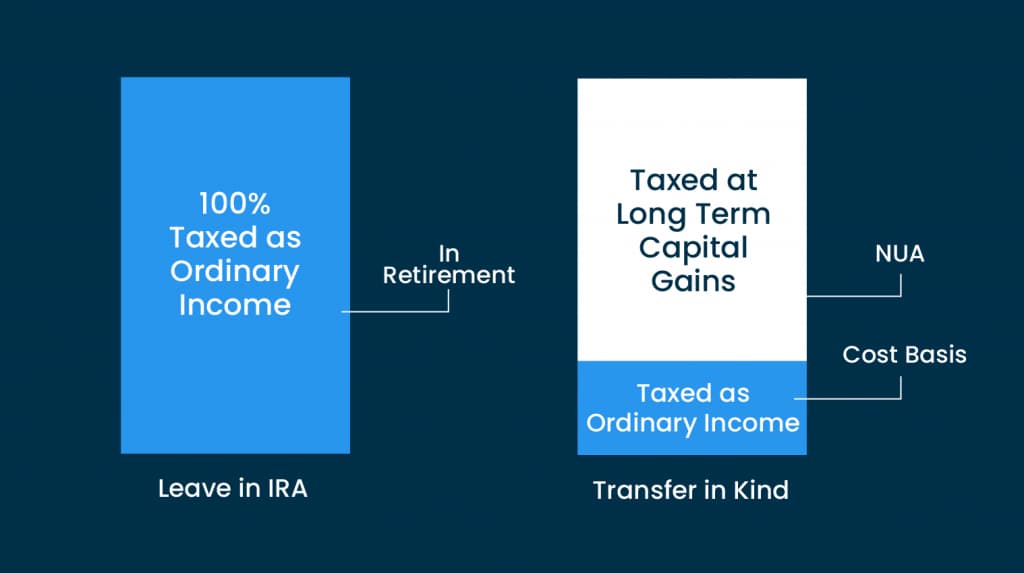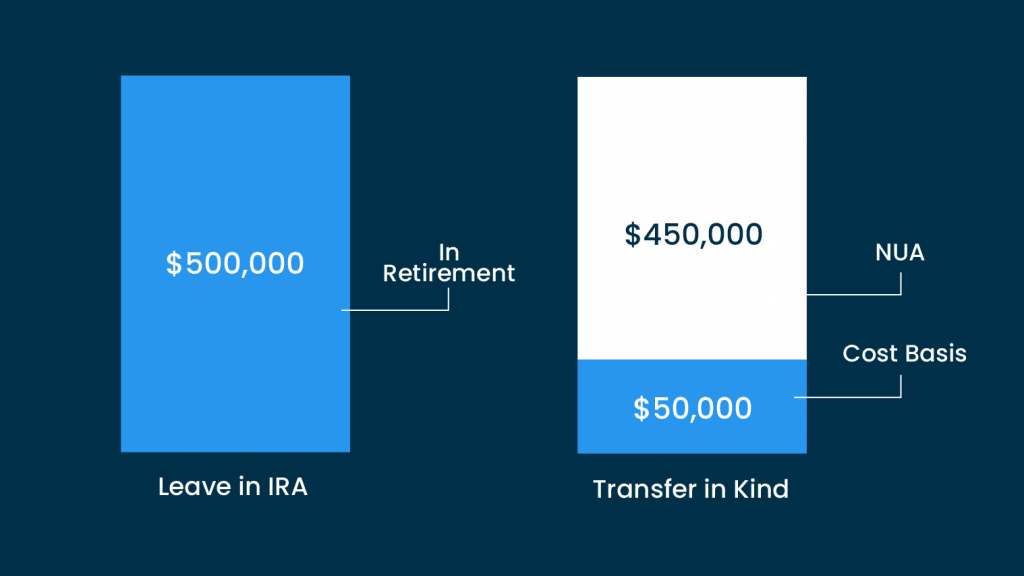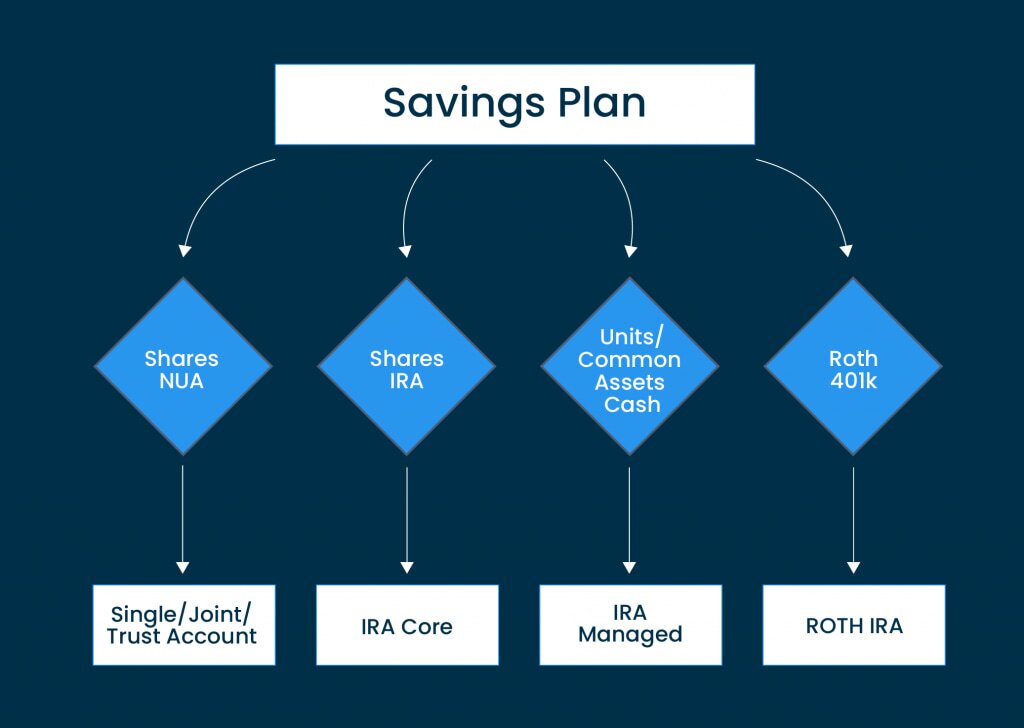NET UNREALIZED APPRECIATION (NUA)
WHAT IS NUA?
Based on IRS Code Section 402, retirement plan participants may consider a net unrealized appreciation (NUA) strategy as a means to lower the tax rate they must pay when they take lump sum distributions from 401(k) and other employer-sponsored plans. Savings can be substantial, particularly for highly appreciated stocks, and for individuals in higher tax brackets.
Distributions may qualify for NUA only after a “triggering event” such as separation from service, reaching age 59 1/2, death or disability. It is important not to take a partial distribution from a savings plan after a triggering event, as this may disqualify the employee for NUA. However, if another triggering event occurs later on, qualification for NUA tax treatment could be reestablished.
INCOME TAX VS. CAPITAL GAINS
Assets that have accumulated value in employer-sponsored tax-deferred accounts are taxed at ordinary income tax rates. This rate, which can be as high as 39.6%, is applied to the current market value of stock and also to any cash that is distributed. However, the NUA strategy provides a means to defer tax payment or to pay a capital gains tax rate on portions of the distribution. Because the Federal long-term capital gains tax rate for most individuals is currently 15%, the NUA strategy can significantly reduce the tax you pay on your distribution, particularly if you are in a higher tax bracket – and if your stock has significantly appreciated since it was contributed to your account.
COST BASIS & UNREALIZED APPRECIATION
The cost basis of your lump-sum distribution is the average value of individual employer shares of stock at the time they were contributed to the retirement plan, or were purchased by the plan’s trustee. The NUA is the difference between this original value and the market value of the stock at time of distribution. For stocks that have appreciated, this is often a significant portion of the total value of the distribution.
THE NUA STRATEGY
Instead of taking the lump-sum distribution, and then paying a high income tax rate on it, you may have your retirement plan distribute your shares of stock to a taxable account. You then pay income tax at the ordinary rate, but only on the cost-basis of the stock. At the same time, you may choose to have mutual funds or any other assets in the plan rolled over into a Traditional IRA, thus retaining their tax-deferred status.
You are not required to pay tax on the NUA at this time, but must do so when you sell the shares, assuming they are still worth more than the cost-basis. Upon the sale of these shares (from your taxable account), you must pay the long-term capital gains rate (currently 15% for most people) on the NUA. This is so even if you’ve held the stock for a year or less. NUA shares are considered long-term from day one of the rollover.
If the NUA of your employer-sponsored retirement plan is large, if your income tax rate is much higher than the capital gains rate, if your stock contributions have gained value – and if this approach fits with your short- and long-term financial goals, this strategy should be considered. We recommend you consult with your financial advisor to look into your particular position prior to making a decision and choosing a plan of action.
TAX TREATMENT


ALL OR NONE
It should be noted here that to qualify for NUA tax treatment, the entire balance of the savings plan retirement account must be rolled over in one calendar year. Any shares beyond the NUA rollover can be rolled to an IRA, along with any cash balance. This cash balance would include proceeds from the sale of any mutual funds in the retirement account, which must be sold to execute the rollover.
TAX-PAID BALANCE
It is possible to apply any after-tax or “tax-paid” balance toward the cost basis when you take distribution. If, for example, you have a $100,000 tax-paid balance in your retirement account, and you apply it to your $100,000 cost basis, your income tax, which otherwise would apply to the cost basis, would be eliminated. The entire rollover would then be tax-free. It is important to understand your tax-free balance. If, while working, you consider making a portion of your regular savings plan after-tax, you will build a tax-paid balance within the plan. This approach will enable more NUA shares to transfer tax-free when you take the distribution.
SHORT-TERM BENEFITS
Let’s say you’ve retired and plan to buy a yacht. Your company stock is worth $500,000 and the plan includes $400,000 in mutual funds. The cost-basis of the stock is $100,000. Let’s assume you’re in the 28% Federal tax bracket, you roll-over the mutual funds into a traditional RIA, and that you’re trying to figure out which strategy for taking the stock assets to buy the boat is the most tax-efficient.
Using the NUA strategy, you have the retirement plan distribute the stock to a taxable account – then pay income tax (28%) on the cost-basis ($100,000), which is $28,000. You then sell the stock and pay long-term capital gains of 15% on the remaining $400,000, which is $60,000. Your total Federal income tax is $88,000.
Instead, if you have your retirement plan sell the stock, roll the proceeds into a traditional IRA, then distribute those proceeds, you must then pay 28% on $500,000, which is $140,000. The NUA would have saved you $52,000, and provided $412,000 to spend on your yacht, rather than $360,000.
But there are other potential benefits to the NUA strategy.
HYPOTHETICAL SAVINGS PLAN

LONG-TERM BENEFITS
Let’s assume employer stock was contributed to your retirement account at a cost basis of $25 per share. Market value is $75 when you take a distribution. You put your stock in a taxable account, where you decide to keep it for a while. At this time you pay ordinary income tax (assume again 28% for this example) only on the cost-basis of $25 per share. The stock continues to appreciate, until it reaches a market value of $100 per share, and you decide to sell it. You then pay long-term capital gains (currently 15%) on the NUA, which is $50 per share, plus long- or short-term capital gains on the subsequent appreciation after distribution from your retirement plan, which would be another $25 per share. The NUA strategy continues to improve tax-efficiency of your stock even after it is distributed to you.
What if your stock loses value after distribution? Any loss in value can be claimed as a long- or short-term capital loss, depending on how long you hold the stock after distribution.
BENEFICIARIES STEP-UP
Take the scenario above, but instead of selling the stock, you hold on to it. When you die, your beneficiaries continue to benefit from your NUA strategy. When they sell their inherited stock, they must pay long-term capital gains on the NUA at the time of distribution (to you), just as you would have had to. However, any appreciation that accrues between the date of distribution and the date of your death would not be subject to income tax. Under current law, they would be entitled to a “stepped-up basis” at the time of inheritance, which makes this additional value part of the cost-basis, rather than part of the NUA. Their tax burden could potentially be a smaller portion of the stock’s market value. Once they inherit, the stock’s value begins to accrue to (or reduce) the NUA again.
OTHER FACTORS TO CONSIDER
At Bogart Wealth, we always recommend a discussion with your advisor before choosing any financial strategy. While this document attempts to provide an accurate general overview of the NUA strategy, there are many factors, both in your own financial situation, as well as in the tax code, stock markets and other variables, that you must consider with your advisor before you can make an informed decision.
- Dividends – under current federal law, dividends are taxed at 15% for most taxpayers, which is less than most income tax rates. The NUA strategy allows an annual tax payment on dividends at this lower rate, rather than paying at the higher income tax rate upon distribution.
- Early Withdrawals – if you pursue a NUA strategy before the age of 59 ½ and place your stock in a taxable account you would not be subject to the 10% early withdrawal tax.
- Creditor Claims – Assets placed outside a qualified employer retirement plan or an IRA may be more susceptible to creditors’ claims.
- Tax Code and Stock Price Changes – The value of your stock may change. The NUA strategy works best for stock that has accrued value since being contributed to your account. Also, a change in the tax code could render the NUA strategy less effective.
- Changes in Tax Rate – if retirement will significantly lower your tax rate, you may see less benefit from the NUA strategy.
- State Income Tax –state income tax laws vary. It is necessary to understand the facts of your particular tax situation, at the state as well as the Federal level, before you choose an approach to improving your tax efficiency.
NUA — ADVANTAGES AND DISADVANTAGES
By submitting this form, you are consenting to receive emails from: Bogart Wealth, 2010 Corporate Ridge, Suite 900, McLean, VA, 22102, US, http://www.bogartwealth.com. You can revoke your consent to receive emails at any time by using the SafeUnsubscribe® link, found at the bottom of every email. Emails are serviced by Constant Contact.
